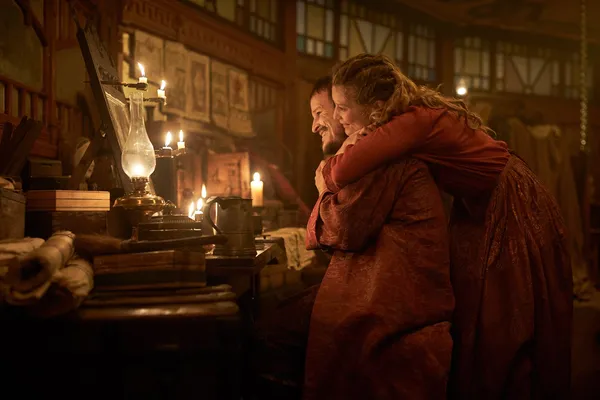 |
| Damon Herriman and Mia Wasikowska in Judy & Punch |
In a little town called Seaside, far from the sea, two travelling performers entertain the locals with their puppets. They work perfectly together, each complementing the other's style, but in private things are very different: Punch (Damon Herriman) drinks and gets aggressive whilst Judy (Mia Wasikowska) struggles to look after their baby. After one of Punch's drinking sessions results in a horrible accident, the tension between them explodes into violence - but Judy isn't about to let herself become just another forgotten victim.
Judy & Punch is the début directorial feature from seasoned Australian actress Mirrah Foulkes, who agreed to connect with me to talk about how it developed.
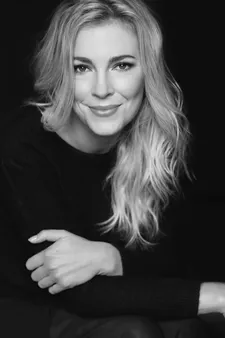 |
| Mirrah Foulkes |
“It was actually brought to me by Vice [Media] in America, of all the places to find a Punch and Judy story. They approached me because they had and idea that they might like to make a live action Punch and Judy movie. They were interested in exploring that story from her perspective – really there was no other way to approach it in 2019.
“I was a long development process. it was the first feature that I’d written so I was very green. I was just figuring out how things worked and how I wanted to write and the kind of tonal world that I wanted to explore. Vice were incredibly supportive in kind of just letting me go rogue and go as bold as I liked with it, and that’s how the whole thing was formed.”
It seems an interesting choice for her first feature as a director, I suggest, given that it’s essentially about actors who also direct.
“It is, isn’t it?” She laughs. “Yeah, funny that. I guess that you consciously or subconsciously get drawn to particular things within a story and bring them out. A lot of it came very organically. I didn’t really sit down – as I probably would now, as a writer – and plot the movie or think hard about what I wanted to be saying thematically or tonally. I just dived right in. While I probably wouldn’t do that again, because it’s really hard and often you find yourself having to go back and redo all the work you’ve already done, if felt really loose and fluid and a bit nutty and bonkers and I just let my imagination go. There’s something particular to this film – it felt like that worked. It was an interesting experiment.”
I note that it felt to me as if, tonally, it had something in common with the tradition of the commedia dell'arte from which the story of Punch and Judy originally emerged.
“Yeah. I did a lot of research about that world because I found it fascinating: the history of puppetry, the history of Punchinello and all of that commedia dell'arte stuff, but I certainly didn’t set out to make something that was historically accurate. I wanted to mess with time and place and I didn’t really care to make a stuffy period film that felt historically accurate, partly just because I wanted to have a very different tone. So that was one choice that I made very early on, to make it feel like a rambling fable or a fantasy.”
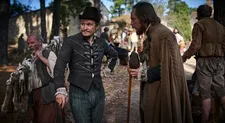 |
| Prelude to an execution |
It captures that sense of timelessness well, I suggest, as if it could be happening anywhere and at any time, even with the violence and the populist politics at the heart of the story.
Mirrah laughs. “Yes! it’s sort of hard not to let that stuff come through. It suddenly appeared and I found that I had these Trumpesque characters and it was sort of interesting. But I guess that comes with those classic stock stories and the repetition of those themes. It feels like it comes through in a lot of popular entertainment. I was kind of fascinated by that, actually. I was interesting in creating something that had quite a classic story structure, like a hero’s journey sort of structure, but messing with that and making it kind of absurd as well. It was fun to play with that and to see what contemporary references popped their heads through in the process, and then to lean into them at places and choose when to let that be very obvious and when to let that feel more subtle. That was a fun part of the process for me.”
The populist characters and their followers also contrast nicely with a group of people we meet who have been cast of the town. How did she go about developing those characters and casting those roles?
“That’s one of those things that’s just universal and timeless, I think,” she says. “And it’s pertinent at the moment – so that was interesting to me, to explore that. It kind of came out of the exploration of the world. I was interested in a mad mishmash of anything other, so it was about gender but not just gender, it was about disability and ethnicity. You can’t actually tell in the film but almost every one of those actors and extras in the heretics’ camp has some form of otherness, whether it’s an obvious disability or there’s deaf actors and actors with physical ailments or mental health problems. There’s a bunch of my friends in there as well! I really wanted that world to feel joyful and nuts and fun and like the strangely healthier version of what was happening in town.
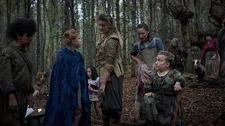 |
| A community of exiles |
“We only shot three days at that location so it was one of the fastest parts of the movie, which was unfortunate, but it was also one of the most joyful. I would have loved to have had more time just to explore that world more, and there’s part of me that enjoyed it more than any other. It was fun to shoot that stuff.”
Then there are the fabulous costumes, which really add to the air of theatricality about the whole thing.
“Yeah. I had a really good time working with Edie Kurzer, my costume designer. It was tough, you know, because we were shooting in Australia where we have nothing like that, so everything had to be either made or hired. She did a trip to the UK and Italy and she saw a lot of costumes for the extras, to hire, and then for the main characters she made everything from scratch. it’s always difficult when you’re on a budget with period stuff. Again one of the great things that we had on our side was the freedom we had to break rules.
“I wanted the town of Seaside to feel very bleak and dirty, and I worked a lot with my cinematographer [Stefan Duscio] to get that visual look for the film. I just didn’t want it to feel crisp and clean in any way, but within that brief Edie managed to find a lot of colour and a lot of humour, I think, within her costumes, which was great.”
Both leads have been praised for their performances. How did she get them on board?
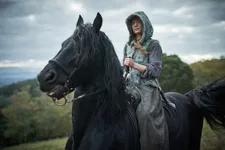 |
| And behold, a dark horse |
“Mia got involve quite early. we were figuring out where we were going to make the film and how we were going to finance it, and we thought the best starting point would be to find Judy. This was way before we were talking about shooting in Australia. We were actually talking about shooting, probably, in the UK somewhere or in Eastern Europe – we were even discussing Italy at one point. Mia was at the top of my list and she was at the top of Vice’s list and I knew her a little bit socially so I got the script to her and she responded to it immediately and very well. So that was easy, it was great. We were all really happy. She is just divine; I really love her. She makes interesting choices in her work and she just felt like the perfect fit.
“Punch was harder because on the one hand there was an expectation that it would be someone who was more commercially viable or more well know. Damon is one of those actors that I have nothing but admiration for. He’s amazing, and he’s fairly well known in Australia but probably less so in the ‘States or in the UK, although he works a lot in America and he’s often that sort of person that everyone’s like ‘I know him fromsomewhere...’”
“So I auditioned Damon. I knew that he’d do something interesting but I had to introduce him to the rest of the film team. It was pretty undeniable from the minute that I saw his test... He’s just so fun. he’s just such a joyful actor to work with. He’s incredibly fastidious and hard working but not to the point of being earnest or serious in any way. He’s able to find that balance between the work ethic and the fun. So he’s a great person to have on set. He comes in and he makes everything better.
“I love his performance – he managed to find so much nuance in there. It’s a really hard role actually. There’s that obvious villainous, violent husband but he’s charming and that’s what I wanted. I wanted to somehow find a way to make Punch charming and I believe that Damon managed that.”
The film industry is disrupted like everything else at the moment, but Mirrah has plenty to keep her occupied.
“I’m working on a couple of things,” she says. “Something that I actually wrote before we shot Judy & Punch, which I’d like to try and make as soon as the world opens back up; and I’m working on another feature with an American writer. I’ve got a couple of TV things on the go as well so I’m sort of juggling development, which is all you can really do at the moment. So as soon as things get back to some semblance of normal, hopefully I’ll be shooting another film, but until then I’ll be writing and trying to use this time to dig into the scripts that I have and see what work can be done.”
Judy & Punch opens in the US on Friday.





















